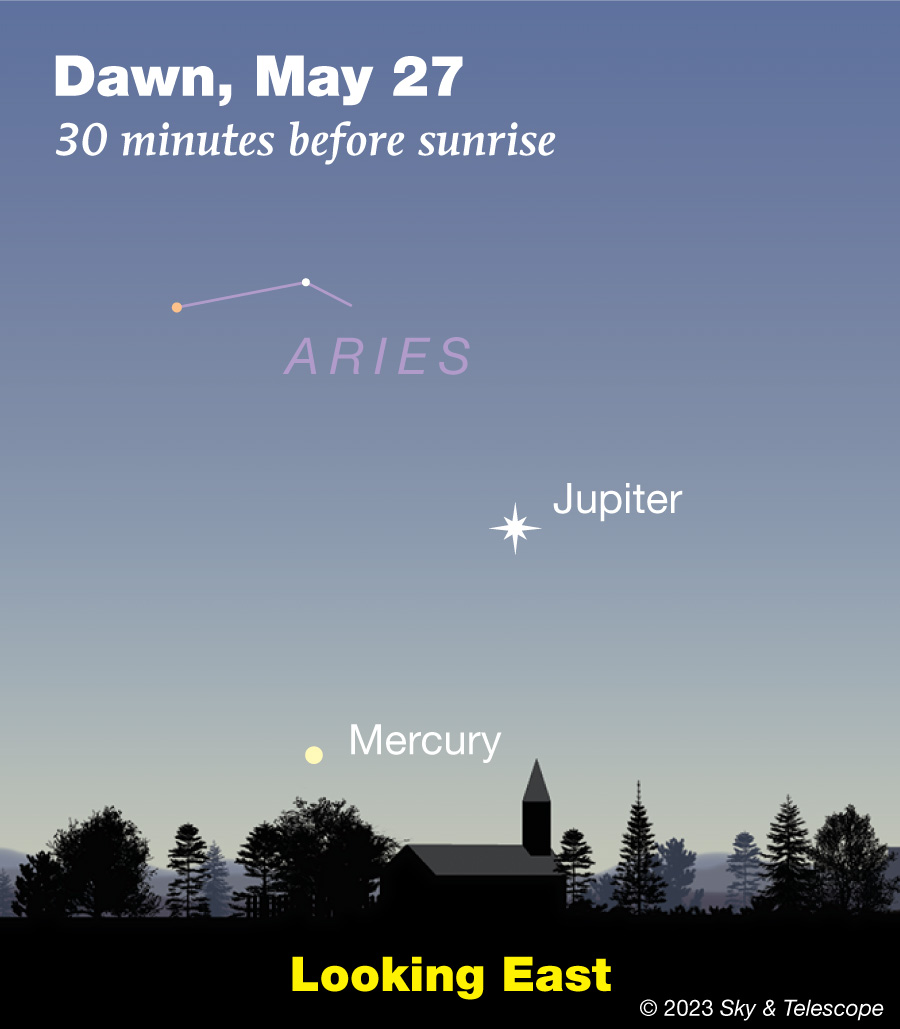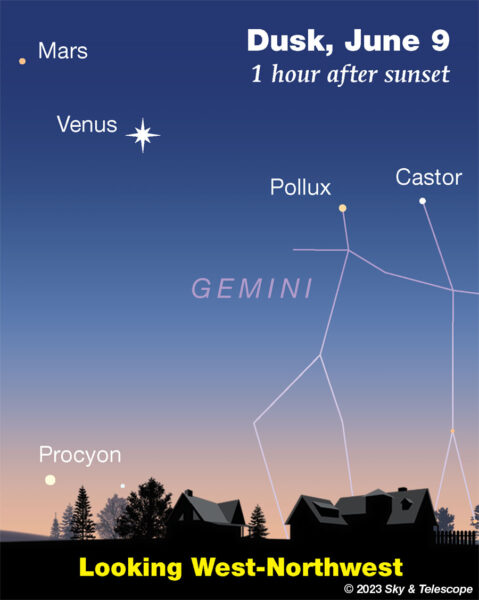Page 34 of 41
Re: Astronomy
Posted: Tue May 23, 2023 12:17 am
by jusplay4fun
CELESTIAL NEWS & EVENTS
BRIGHT SUPERNOVA BLAZES IN M101, THE PINWHEEL GALAXY
BY: BOB KING MAY 22, 2023 2
GET ARTICLES LIKE THIS SENT TO YOUR INBOX
Email (required) *
Constant Contact Use.
A supergiant star exploded as a supernova in the prominent galaxy M101 in Ursa Major. It’s now bright enough to see in a 4.5-inch telescope!
https://skyandtelescope.org/astronomy-n ... xy%20M101.
Re: Astronomy
Posted: Tue May 23, 2023 1:55 pm
by jusplay4fun
Actual thought: the phenomena of supernovae are rare occurrences.
Re: Astronomy
Posted: Fri May 26, 2023 2:37 am
by jusplay4fun
Re: Astronomy
Posted: Fri Jun 02, 2023 12:47 am
by jusplay4fun
The Earth Isn’t a Perfect Sphere
If you had to make a model of the solar system in an elementary science class, your nine planets (or eight, depending on your age) were likely perfect foam spheres. While that’s a pretty good approximation, it’s not entirely accurate. The Earth is actually an irregularly shaped ellipsoid — its middle bulges due to the centrifugal force of its constant rotation. Scientists have determined that the Earth’s sea level is actually about 13 miles farther from its center at the equator than at the poles. Plus, the Earth’s shape is constantly changing.
Re: Astronomy
Posted: Fri Jun 02, 2023 1:14 pm
by jimboston
jusplay4fun wrote:The Earth Isn’t a Perfect Sphere
If you had to make a model of the solar system in an elementary science class, your nine planets (or eight, depending on your age) were likely perfect foam spheres. While that’s a pretty good approximation, it’s not entirely accurate. The Earth is actually an irregularly shaped ellipsoid — its middle bulges due to the centrifugal force of its constant rotation. Scientists have determined that the Earth’s sea level is actually about 13 miles farther from its center at the equator than at the poles. Plus, the Earth’s shape is constantly changing.
Another post where JP4 shares a link and info to common knowledge we all learned in 3rd grade.



Re: Astronomy
Posted: Fri Jun 02, 2023 2:20 pm
by jusplay4fun
jimboston wrote:jusplay4fun wrote:The Earth Isn’t a Perfect Sphere
If you had to make a model of the solar system in an elementary science class, your nine planets (or eight, depending on your age) were likely perfect foam spheres. While that’s a pretty good approximation, it’s not entirely accurate. The Earth is actually an irregularly shaped ellipsoid — its middle bulges due to the centrifugal force of its constant rotation. Scientists have determined that the Earth’s sea level is actually about 13 miles farther from its center at the equator than at the poles. Plus, the Earth’s shape is constantly changing.
Another post where JP4 shares a link and info to common knowledge we all learned in 3rd grade.



Please show us what else you know about this topic BEFORE I post something.
Re: Astronomy
Posted: Fri Jun 02, 2023 3:32 pm
by Maxleod
jusplay4fun wrote:jimboston wrote:jusplay4fun wrote:The Earth Isn’t a Perfect Sphere
If you had to make a model of the solar system in an elementary science class, your nine planets (or eight, depending on your age) were likely perfect foam spheres. While that’s a pretty good approximation, it’s not entirely accurate. The Earth is actually an irregularly shaped ellipsoid — its middle bulges due to the centrifugal force of its constant rotation. Scientists have determined that the Earth’s sea level is actually about 13 miles farther from its center at the equator than at the poles. Plus, the Earth’s shape is constantly changing.
Another post where JP4 shares a link and info to common knowledge we all learned in 3rd grade.



Please show us what else you know about this topic BEFORE I post something.
I'm not Jimboston, but your quote says it's because of the "centrifugal force of its constant rotation".
I thought it was because of Earth's magnetic poles?
Re: Astronomy
Posted: Fri Jun 02, 2023 6:53 pm
by jusplay4fun
Maxleod wrote:jusplay4fun wrote:jimboston wrote:jusplay4fun wrote:The Earth Isn’t a Perfect Sphere
If you had to make a model of the solar system in an elementary science class, your nine planets (or eight, depending on your age) were likely perfect foam spheres. While that’s a pretty good approximation, it’s not entirely accurate. The Earth is actually an irregularly shaped ellipsoid — its middle bulges due to the centrifugal force of its constant rotation. Scientists have determined that the Earth’s sea level is actually about 13 miles farther from its center at the equator than at the poles. Plus, the Earth’s shape is constantly changing.
Another post where JP4 shares a link and info to common knowledge we all learned in 3rd grade.



Please show us what else you know about this topic BEFORE I post something.
I'm not Jimboston, but your quote says it's because of the "centrifugal force of its constant rotation".
I thought it was because of Earth's magnetic poles?
Centrifugal forces pushes matter out from its center of rotation. (I think of a centrifuge, doing that same thing.) The earth tends to be flatter at the geographic (North and South) poles, and the magnetic poles are nearby. Otherwise, I see NO connection to the magnetic poles for the earth's bulge in the middle.
Re: Astronomy
Posted: Mon Jun 05, 2023 3:20 am
by jusplay4fun
Brilliant Venus and much-dimmer Mars await you in the western sky after sunset during June. Toward month’s end, they’ll be joined by a lovely crescent Moon.
Sky & Telescope
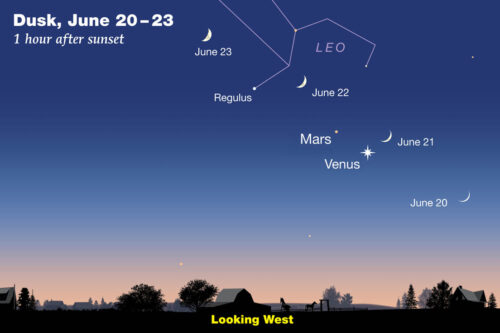
Stargazers crave darkness. But for those of us in the Northern Hemisphere, June offers the shortest nights of the year. This month’s solstice occurs on the 21st at 10:58 a.m. EDT. For someone at a latitude of, say, 40° north, which runs from Salt Lake City through Philadelphia and over to Madrid, that day will offer 15 hours of sunlight. So you can count on our monthly Sky Tour podcast to help you get the most out your casual stargazing on June’s short nights.
In early evening, you can easily track down Earth’s two closest planetary neighbors. Venus is the obvious beacon over in the west after sunset. Venus has been climbing higher up with each passing week, and on June 4th the brilliant planet is situated its farthest from the sun in the sky, what astronomers term greatest elongation. With so much separation, Venus won’t set until more than 3 hours after the Sun does.
The other planet in this general vicinity is Mars, which is to the upper left of Venus but a lot dimmer. Mars is sliding a bit lower each night, while Venus is holding its own. So as June opens, the two planets are separated by about the width of your clenched fist on an outstretched arm. By month’s end they’ll be just a few degrees apart. And is a spectacularly tight paring of these two planets coming up soon? You’ll have to listen to June’s Sky Tour to find out!
https://skyandtelescope.org/observing/s ... june-2023/
Re: Astronomy
Posted: Mon Jun 05, 2023 7:22 am
by Dukasaur
It's been really cool seeing Venus this bright and this high in the sky.
Re: Astronomy
Posted: Mon Jun 05, 2023 8:29 am
by KoolBak
I'm your Venus....I'm your fire .....
Re: Astronomy
Posted: Tue Jun 06, 2023 6:38 am
by Dukasaur
For as long as Betelgeuse has been discussed in the news, it has always been said that it will probably go supernova within 10,000 years.
A new paper published just last week, however, puts for the proposition that Betelgeuse is in the late stages of carbon compression, and could go supernova on a time scale of tens, not thousands of years. That means, with a bit of luck, I could see it in my lifetime.
https://earthsky.org/brightest-stars/be ... e-someday/
Probably the most exciting news in astronomy in years! We could live to see a supernova!
Re: Astronomy
Posted: Tue Jun 06, 2023 3:36 pm
by jusplay4fun
Dukasaur wrote:For as long as Betelgeuse has been discussed in the news, it has always been said that it will probably go supernova within 10,000 years.
A new paper published just last week, however, puts for the proposition that Betelgeuse is in the late stages of carbon compression, and could go supernova on a time scale of tens, not thousands of years. That means, with a bit of luck, I could see it in my lifetime.
https://earthsky.org/brightest-stars/be ... e-someday/
Probably the most exciting news in astronomy in years! We could live to see a supernova!
‘It’s new territory’: why is Betelgeuse glowing so brightly and behaving so strangely?
After the ‘great dimming’, the closest red supergiant star to Earth is pulsating twice as fast as usual and lighting up the southern hemisphere’s early evening sky
Helen Sullivan
Thu 25 May 2023 23.52 EDT
One of the brightest stars in the sky is behaving strangely, pulsating from bright to dim twice as fast as usual and giving scientists an unprecedented insight into how stars die.
Betelgeuse, the closest red supergiant to Earth, has long been understood to move between brighter and dimmer in 400-day cycles. But from late 2019 to early 2020, it underwent what astrophysicists called “the great dimming”, as a dust cloud obscured our view of the star.
Now, it is glowing at 150% of its normal brightness, and is cycling between brighter and dimmer at 200-day intervals – twice as fast as usual – according to astrophysicist Andrea Dupree of the Harvard-Smithsonian Centre for Astrophysics. It is currently the seventh brightest star in the night sky – up three places from its usual tenth brightest.
https://www.theguardian.com/science/202 ... he%20star.
There is a video, almost 6:00 minutes long, at the URL above.
also:
A star is reborn: dust cloud blamed for dimming of Betelgeuse
https://www.theguardian.com/science/202 ... betelgeuse
Re: Astronomy
Posted: Wed Jun 07, 2023 8:04 am
by jusplay4fun
More on Betelgeuse:
Betelgeuse in the night sky
At mid-northern latitudes, around the first of every year, Betelgeuse rises around sunset. The star is prominent on January and February evenings.
By the beginning of March, this star is due south in early evening. By mid-May, it is briefly visible in the west after sunset. Betelgeuse is traveling behind the sun in early summer, but it returns to the east before dawn by about mid- to late July. Certainly, by early August, you can see Betelgeuse in Orion in the east before sunrise, where the constellation is known as the ghost of the summer dawn.
The star Betelgeuse has a distinctive muted orange-red color. It’s ideal for convincing non-believers that stars do, in fact, come in colors.
Stars designated as Alpha are typically brightest in their constellations. But Betelgeuse is Alpha Orionis, despite the fact that it’s fainter than Orion’s other bright star, Rigel.
Betelgeuse is the 10th-brightest star in the sky overall, and it’s the 7th-brightest star visible from most of the U.S., Canada, Europe and the majority of the Northern Hemisphere.
https://earthsky.org/brightest-stars/be ... e-someday/
Re: Astronomy
Posted: Wed Jun 07, 2023 10:10 pm
by ConfederateSS
--------------
Last night, from the haze caused by The Canadian wild fires in the east....The haze reached Detroit/Windsor.....But more in the sky....The Moon was orange, because of the haze....It looked like a Harvest Moon in the Fall...But not as big....Kool  though...See tonight if it is still orange...
though...See tonight if it is still orange......

ConfederateSS.out!(The Blue and Silver Rebellion)...

Re: Astronomy
Posted: Thu Jun 08, 2023 12:52 am
by ConfederateSS
ConfederateSS wrote:--------------
Last night, from the haze caused by The Canadian wild fires in the east....The haze reached Detroit/Windsor.....But more in the sky....The Moon was orange, because of the haze....It looked like a Harvest Moon in the Fall...But not as big....Kool  though...See tonight if it is still orange...
though...See tonight if it is still orange......

ConfederateSS.out!(The Blue and Silver Rebellion)...

---------
The haze is still there on the Moon(well the sky)...tonight.......

ConfederateSS.out!(The Blue and Silver Rebellion)...

Re: Astronomy
Posted: Thu Jun 08, 2023 1:09 am
by jusplay4fun
ConfederateSS wrote:ConfederateSS wrote:--------------
Last night, from the haze caused by The Canadian wild fires in the east....The haze reached Detroit/Windsor.....But more in the sky....The Moon was orange, because of the haze....It looked like a Harvest Moon in the Fall...But not as big....Kool  though...See tonight if it is still orange...
though...See tonight if it is still orange......

ConfederateSS.out!(The Blue and Silver Rebellion)...

---------
The haze is still there on the Moon(well the sky)...tonight.......

ConfederateSS.out!(The Blue and Silver Rebellion)...

In Virginia the haze is expected until at least this weekend. I can smell the smoke in the air.
Re: Astronomy
Posted: Fri Jun 09, 2023 2:51 am
by ConfederateSS
----------
Just a little haze on the Moon tonight...Sometimes the wind current, goes in a circular pattern... Hopefully the little haze is on its way out... Hopefully, the wild fires will die down...The Canadian people can have some break in the smoke filled air, fire damage......

ConfederateSS.out!(The Blue and Silver Rebellion)...

...About you can smell the smoke Jp4fun, It is the same here, although in Southwest Detroit, the smoke does have a forest,bon fire smell, because of the haze, but most of the time , in Southwest Detroit you can smell smoke, house fire/smoke smell is the night time air smell...More so in the winter, the cold still air, causes the smell to stay around longer...House fire smell is a nasty smell...It is not the bon/camp fire smell people like to sit around...
Re: Astronomy
Posted: Fri Jun 09, 2023 3:01 am
by jusplay4fun
Re: Astronomy
Posted: Sun Jun 11, 2023 2:49 am
by jusplay4fun
Re: Astronomy
Posted: Tue Jun 20, 2023 3:52 pm
by jusplay4fun
EKING OUT OBSERVING FROM UNDER WILDFIRE SMOKE
BY: BOB KING JUNE 14, 2023
Smoke from Canadian wildfires has made observing the night sky a challenge for many. Here are some ways you can make the best of a bad situation.
https://skyandtelescope.org/astronomy-n ... ire-smoke/
Re: Astronomy
Posted: Sat Jun 24, 2023 8:13 am
by jusplay4fun
THURSDAY, JUNE 29
■ The Moon tonight shines about two thirds of the way from Spica, way off on its right, to Antares waiting for it on its left.
FRIDAY, JUNE 30
■ The Moon shines among the stars of upper Scorpius. The brightest of these is orange Antares about 2° or 3° to the Moon's lower left (for North America). Next brightest is Delta Scorpii, farther to the Moon's upper right. Binoculars help through the moonlight and summer haze.
■ Mars and Venus are now at their minimum separation for this apparition, 3.6° apart, as shown below. Mars will remain in low twilight view for more than a month to come. Venus will drop away faster.
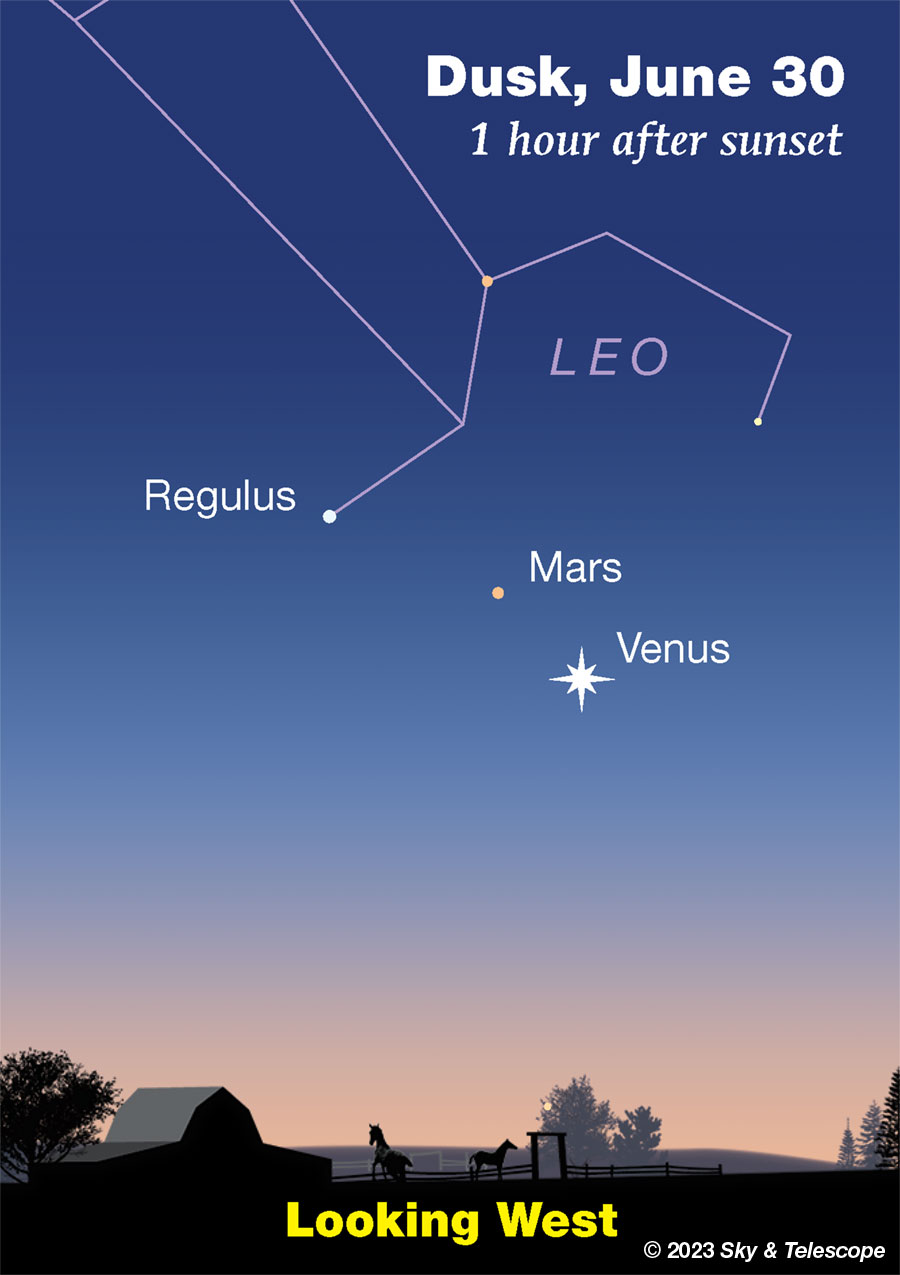
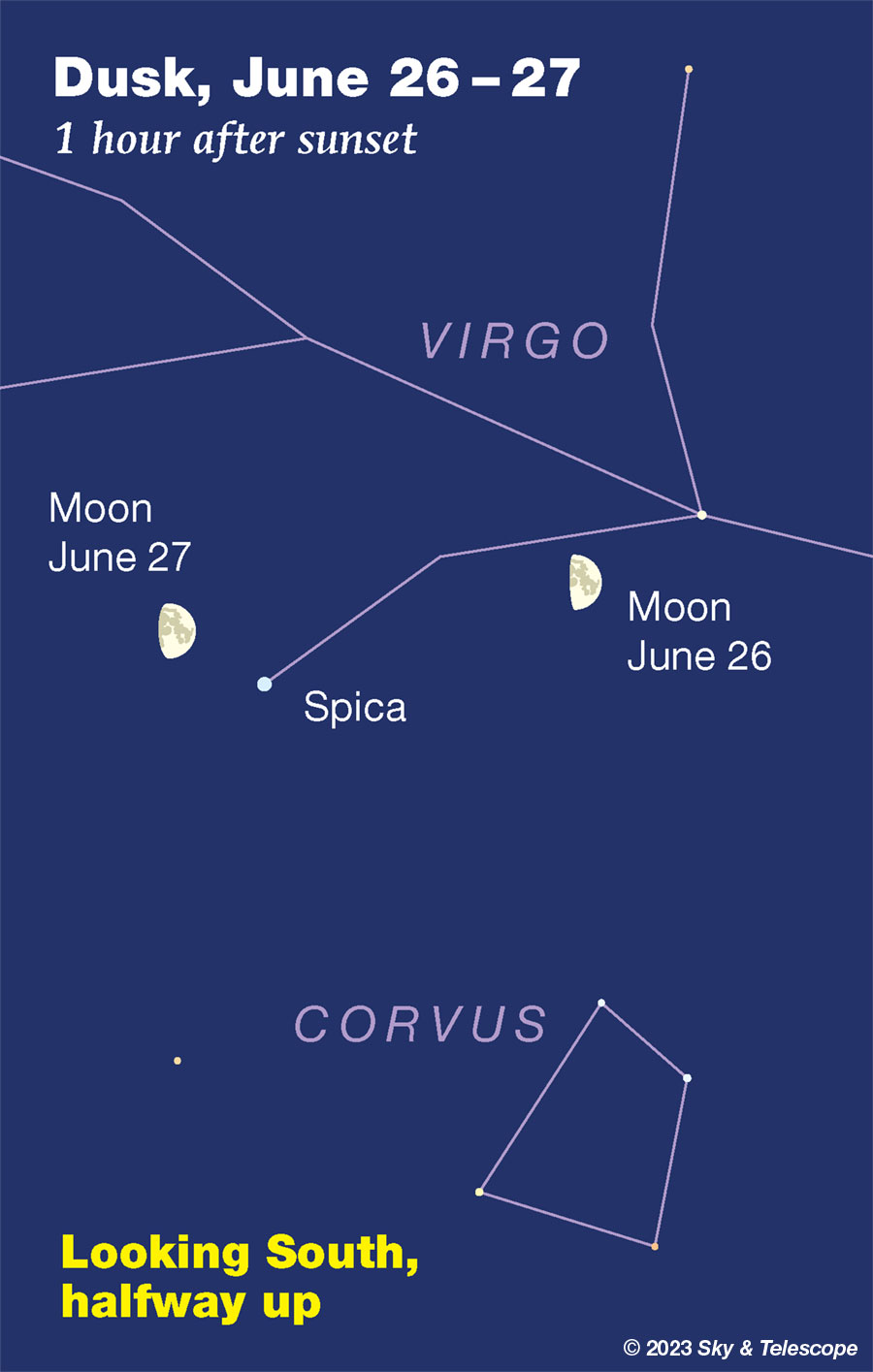 https://skyandtelescope.org/astronomy-n ... 23-july-3/
https://skyandtelescope.org/astronomy-n ... 23-july-3/
Re: Astronomy
Posted: Sat Jun 24, 2023 8:34 am
by GaryDenton
We will have a close-up view of a supernova, perhaps very soon. It depends on how big that star actually is.
https://www.inverse.com/science/study-s ... s-disagree
Re: Astronomy
Posted: Sat Jun 24, 2023 2:07 pm
by jusplay4fun
If you read up to June 6-7, on this same page, you will see that we (Duk and I) have discussed this to some extent.
Re: Astronomy
Posted: Sat Jul 08, 2023 7:53 pm
by Serbia
Northern Lights might be visible in multiple states Thursday 7/13.
